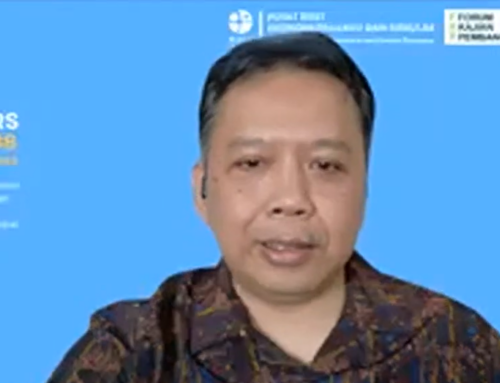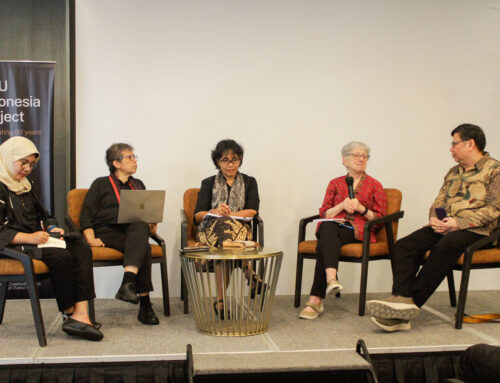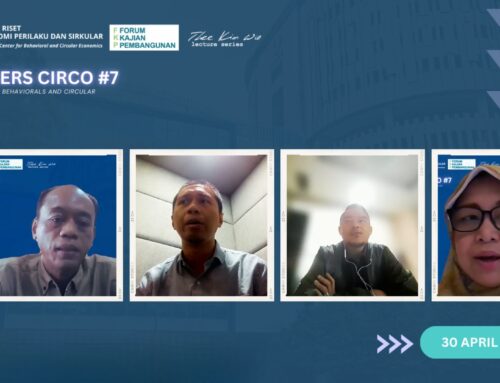Speakers and organizers at Universitas Udayana
FKP hosted by Universitas Mataram and Universitas Udayana with Professor Budy Resosudarmo (The Australian National University), Dr Saiful Mahdi (Universitas Syiah Kuala), Dr I Nyoman Mahaendra Yasa (Universitas Udayana), and Dr Diswandi (Universitas Mataram). Tuesday and Wednesday, 1 & 2 March 2022.
KEY POINTS:
- FKP 2022 Roadshow discussed steps to increase community resilience to disasters in Indonesia based on the latest research. Dr. Saiful Mahdi from Syiah Kuala University presented a study on the socio-economic perspective of Aceh’s post-tsunami experience in 2004. Some of the main findings of research pointed out that some of the disaster assistance was not used optimally by the recipients due to incompatibility with the community’s needs. A seriously planned reconstruction is important, because many new issues have emerged after the disaster, such as gender issues and economic segregation.
- Prof. Budy P. Resosudarmo from The Australian National University explained about Disaster Index Insurance which is still rarely studied in Indonesia. Regional risk index-based insurance pays benefits based on a predetermined regional index. In 2018, an experiment was conducted on the willingness to pay for insurance based on the flood index among about 800 households in Jakarta. The results of the study show that the demand for insurance based on the flood index is likely not small.
- Dr I Nyoman Mahaendra Yasa from Udayana University explained the issues and strategies for Bali’s economic recovery during the COVID-19 pandemic. The province of Bali is the province that has been hardest hit economically during the pandemic, due to its high dependence on the tourism sector. In the future, a special strategy is needed to restore and restore the Balinese economy. The good image of tourism and the readiness to open tourist destinations that are safe from COVID-19 needs to be improved.
- Dr. Diswandi from Mataram University presented Payment for Ecosystem Services (PES) as an alternative for sustainable tourism development. The rapid growth of the tourism industry can have a negative impact on the carrying capacity of the environment both on land and at sea. To formulate PES, a study of willingness to pay (WTP) and willingness to receive (WTA) is needed to determine supply and demand. The results of this study indicate that the PES Program has the potential to be developed in Gili Matra to promote a sustainable tourism industry.
SUMMARY
- In collaboration with regional universities in Indonesia, the ANU Indonesia Project organized the annual FKP Roadshow, to encourage regional Indonesian academics to conduct research on topics that are currently important to their region. This year, in collaboration with Universitas Syiah Kuala, Universitas Udayana and Universitas Mataram, the FKP Roadshow was held in Denpasar, Bali, on March 1 and in Mataram, Lombok on March 2. The roadshow in Denpasar was attended in-person by approximately 70 participants consisting of undergraduate and postgraduate students and young lecturers. Approximately 230 people attended on Zoom and 160 people on YouTube. The roadshow in Mataram was attended in-person by approximately 45 participants, most of whom were postgraduate students and junior lecturers. Approximately 140 people attended on Zoom and approximately 160 on YouTube.
- At Udayana, Anthea Griffin, Australia’s Consul General in Bali, gave remarks at the event emphasizing how vulnerable Indonesia is to natural disasters, and that Australia is now also facing the same challenges with flooding in the states of New South Wales and Queensland. Therefore, the topic of disaster resilience discussed in this seminar is very important for the two countries.
- Dr. Saiful Mahdi from Syiah Kuala University presented a study on the socio-economic perspective of Aceh’s post-tsunami experience in 2004. Indonesia was the hardest hit by the earthquake and tsunami with the largest number of casualties. After the disaster, the response from the global community came massively. The assistance, among others, is to carry out post-disaster reconstruction and recovery in Aceh and its surroundings. Dr Saiful Mahdi conducted research to assess the sustainability of post-tsunami aid and development projects in Aceh, Indonesia. Some of the main findings of his are as follows:
- disaster assistance was not used optimally by the recipients due to incompatibility with the community’s needs. For example, boat donations for fishermen in Aceh were not used because the types of boats were very different from the ones they had and did not suit the needs of fishermen in the area, which eventually resulted in the abandonment of these boats. From the government side, the government actually returned to business as usual after the disaster, without any changes in development for the better. Post-disaster reconstruction requires a better rebuilding approach, not just a return to normalcy.
- many new issues have emerged after the disaster, such as gender and economic segregation issues, which were initially not included in the relief and reconstruction plans. Data on domestic violence and divorce rates in Aceh show a spike in cases after the 2004 tsunami. In addition, the disaster-prone parts of the city tend to be inhabited by poorer people, giving rise to new socio-economic segregation in the tsunami-affected areas. Land prices in non-tsunami-affected areas (inland) became higher, and subsequently the poverty rate in tsunami-affected areas was much higher than in inland areas. Newcomers who are poor will live in vulnerable areas, and those who are richer can afford to live in areas that are not vulnerable.
- Prof. Budy P. Resosudarmo from The Australian National University explained about Disaster Index Insurance which is still rarely studied in Indonesia. Disasters can have enormous socioeconomic consequences, especially among the poor. These impacts can be long-lasting, and in some cases permanent. A case study of the 2006 earthquake in Bantul shows the importance of distributing financial aid as early as possible. Receiving financial support is an important factor for a speedy recovery, although its effectiveness may diminish over time. This highlights the importance of relatively basic universal insurance that can be disbursed quickly.
- Parametric insurance (also called regional risk index-based insurance) is an insurance product that pays benefits based on a predetermined regional index. Its main problems are reduced selection problems and moral hazard, low transaction costs, and potentially rapid distribution of benefits. However, the drawback is that it does not cover the full basic risk of the insurer because regional risk is not always the same as individual risk. One example of index-based insurance can be applied to flood areas in Jakarta. The concept of flood index-based insurance is that households in the local watershed pay a monthly premium (price) for flood index-based insurance. This insurance product refers to a certain water level (threshold) registered at the nearest floodgate/water station. Compensation is given to the policyholder when the actual water level (index) crosses that threshold.
- In 2018, an experiment was conducted on the willingness to pay for insurance based on the flood index among about 800 households in Jakarta. The results of the study show that the demand for insurance based on the flood index is likely not small. For index-based flood insurance with a payment of Rp 10 million, the average willingness to pay a premium is around Rp 50 thousand per month.
- Dr I Nyoman Mahaendra Yasa from Udayana University explained the issues and strategies for Bali’s economic recovery during the COVID-19 pandemic. The province of Bali is the province that has been hardest hit economically during the pandemic, due to its high dependence on the tourism sector. Issues that are important in Bali include the shift in small and medium enterprises from formal to informal, the vulnerability of the tourism sector, the decline in tourist confidence, and disparities between sectors and regions.
- Tourism has started to recover. The average room occupancy rate in Quarter IV-2021 has increased compared to Quarter III-2021. Bali’s economic growth has also started to improve. Although there are indications of improvement, the unemployment rate in Bali is still high compared to the situation before the pandemic. It is very clear that the area in Denpasar, Badung, Gianyar and Tabanan (often called “Sarbagita”) has a high unemployment rate because the region relies on tourism, while other areas of Bali can still depend on agriculture. In the future, a special strategy is needed to restore and restore the Balinese economy. Health protocols in all aspects of economic activity were tightened and vaccination was accelerated. The good image of tourism and the readiness to open tourist destinations that are safe from COVID-19 needs to be improved through the strengthening of Testing, Tracing, and Treatment (3T). Synergy and connectivity between regions also need to be strengthened.
 Speakers and organizers at Universitas Udayana
Speakers and organizers at Universitas Udayana
- Tourism has started to recover. The average room occupancy rate in Quarter IV-2021 has increased compared to Quarter III-2021. Bali’s economic growth has also started to improve. Although there are indications of improvement, the unemployment rate in Bali is still high compared to the situation before the pandemic. It is very clear that the area in Denpasar, Badung, Gianyar and Tabanan (often called “Sarbagita”) has a high unemployment rate because the region relies on tourism, while other areas of Bali can still depend on agriculture. In the future, a special strategy is needed to restore and restore the Balinese economy. Health protocols in all aspects of economic activity were tightened and vaccination was accelerated. The good image of tourism and the readiness to open tourist destinations that are safe from COVID-19 needs to be improved through the strengthening of Testing, Tracing, and Treatment (3T). Synergy and connectivity between regions also need to be strengthened.
- Dr. Diswandi from Mataram University presented Payment for Ecosystem Services (PES) as an alternative for sustainable tourism development. Marine tourism has become one of the main features in the tourism industry in Indonesia. However, tourism activities so far are still more focused on economic benefits with a disregard to potential environmental damage if conservation efforts are not paid attention to. In this regard, one of the marine tourism sites that is currently developing very rapidly in Eastern Indonesia is Gili Matra, North Lombok, West Nusa Tenggara. The main attraction for tourists on Gili Matra is the beauty of the marine park including coral reefs and marine life around it. The number of tourist visits to Gili Matra at normal times is increasing causing an increase in the number of hotels, accommodation and other supporting infrastructure. The rapid growth of the tourism industry can have a negative impact on the carrying capacity of the environment both on land and at sea.
- One potential effort to solve this problem is the Payment for Ecosystem Services (PES) program. PES is a voluntary transaction in which a clearly identified environmental service is purchased by at least one buyer of environmental services from at least one provider of environmental services on the condition that the provider continues to conserve the associated resources to ensure the sustainability of environmental services. To formulate PES, a study of willingness to pay (WTP) and willingness to receive (WTA) is needed to determine supply and demand.
- The results show that international tourists are willing to pay $21.46 per visit to conserve resources, while local tourists are willing to pay IDR 35,000 per visit. Tourism entrepreneurs are willing to pay IDR 52,000 per month. In terms of conservation, fishing households are willing to receive Rp1,326,000 per month to help with coral conservation. The results of this study indicate that the PES Program has the potential to be developed in Gili Matra to promote a sustainable tourism industry. However, further studies are still needed to design a PES Program that meets the conditions in Gili Mantra.





